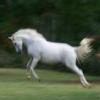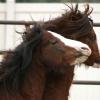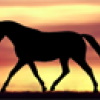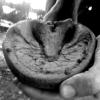Weight gain handout
Forums
Re: Weight gain handout
[quote="accphotography"]Hah!! How about one for weight LOSS!?!?[/quote]
Strangely enough ad lib hay again :rofl (with no other calorie source) Seriously, it works. I feed them so much hay I think they get bored with it and start eating less because they are looking for something better and they know the hay isn't going to run out. :twisted: Of course finding a lower calorie hay helps with that too. The worst you can do is start limiting their eating [i]amount[/i]. They start eating everything in site like pigs since they get hungrier while waiting for the next meal and are afraid to waist any of the precious noms.
Re: Weight gain handout
Ok, next revision. The formatting didn't copy through right, but there is bolding/underlining/etc in the actual document.
[quote]Weight Gain Diet
The best way to put weight on a horse is to feed fiber and fat.
Fiber: Horses are designed to digest fiber using hind gut fermentation. In the wild, horses
will graze nearly continuously on fiber, which the fermentation turns into a great source
of energy.
Hay or pasture- high quality hay or grazing is the best source of fiber for a horse and the
most natural food for them to eat. The higher the quality that the hay is, the more a horse
will eat of it. Feed hay ad lib for weight gain. 1000lb horses should have 15-20 lbs of
hay a day for maintaining weight and more, 20-30lbs, for weight gain. This number is
about 1.5-2% of the body weight for maintenance and 2-3% for weight gain.
Hay pellets- If a horse has difficulty eating due to dental problems or other health
concerns, hay pellets are an alternative to hay.
Beet pulp- For a 1000 lb horse, 2-4 lbs (~2-4 quarts) per day split into two or more meals.
Soak the beet pulp in warm water for 1-4 hours before feeding. Try mixing with hay
pellets or a small amount of concentrate to make it more palatable.
Senior/high fiber concentrate feed- This diet is designed to be fed to horses that are
unable to eat hay as a food source (usually due to poor teeth from old age) and is meant
to be a complete feed. Complete feeds are designed to be fed as the sole source of
nutrients for the horse, which requires feeding 12-16 lbs per day. If your horse is able to
eat hay or hay pellets, then a smaller volume of senior can be fed for some supplemental
energy. Some brands contain high non-structural carbohydrates (simple sugar), which can
cause problems in founder prone or insulin resistant horses.
Fat: Fat has 2.5 times the amount of calories than equivalent weight of carbohydrates
or protein so is great for getting more calories into an underweight horse. Fat is safer
to feed horses than carbohydrates (grains/sugar) because it is not linked to founder like
carbs; any excess fats just end up passing through the digestive tract. Grasses have a good
amount of fat and horses are uniquely designed to extract the fat for energy. The total
amount of fat fed in the diet should be no more than 15% of the total weight of food eaten
or no more than 3 lbs for a 1000lb horse (all fat sources combined- for example: oil+rice
bran+flax seed - should be no more than 3 lb).
Corn/Vegetable/Coconut Oil- a good source of concentrated fat. Start with feeding 2
tablespoons top-dressing concentrates or hay. This can be increased slowly to allow the
flora of the digestive tract to adapt to the new energy source. A 1000lb horse can eat up
to a total of 1-2 cups of oil a day, split into multiple feedings.
Rice bran- Both a fat and fiber source, rice bran is highly palatable. Rice bran is high
in phosphorus so no more than ½ lb (~2 cups) per day should be fed without a calcium
supplement to balance the minerals.
Flax Seed- a good source of balanced omega fatty acids and protein. Flax seed must be
ground to be digested, but will go rancid in about less than a week so must be freshly
ground. A few days worth can easily be ground in a coffee grinder and refrigerated to
keep longer.
Black oil sunflower seeds (BOSS)- These small, black seeds can be fed with the hull on
and are a good source of fat, protein and fiber. Start feeding ½ a cup and can increase to
1-2 lbs.
High fat concentrates- There are several high fat concentrates available on the market that
are designed for increasing energy in the diet. These concentrates are usually 12-25% fat.
Examples of these feeds are LMF Performance, Nutrena XTN or Purina Ultima.
Carbohydrate: Carbohydrates, also called sugars, are found in high amount in grains
(oat, corn, barley, molasses, sugar) and are not a good source of added energy in a diet.
Non-structural carbohydrates are simple sugars and, if overfed, can lead to colic and
laminitis/founder. Carbs should also be restricted in horses with the disease conditions
like chronic founder, Cushing’s disease, metabolic syndrome and insulin resistance.
Protein: Horses require about 6-9% protein in their diet. Most good quality hays contain
more than enough protein to cover this requirement. If a horse is in hard training and
actively building muscle, they may require supplemental protein. These can be added
using 10-12% protein concentrate feeds or adding alfalfa to the diet.
Vitamin: Most of the vitamin requirements for horses can be obtained from pasture
grazing. Hay that is older than 1-2 months will have lost most its vitamin content so
horses on hay diets need a vitamin supplement.
Mineral: The Pacific Northwest region is completely deficient in copper, cobalt,
selenium and zinc in the soil. Because of this, all locally grown hay (Washington, Oregon
and Idaho) and pastures are lacking these minerals. Horses in this region need to be
supplemented with minerals designed for the area.
Free choice, low salt mineral supplement- Mineralized salt blocks are ~98% and the
high salt tends to prevent the horse from getting enough minerals. A low-salt free
choice mineral can be fed free choice (in a bucket under cover) so the horse can regulate
its mineral intake. This should be fed with a plain salt block and no other mineral
supplement should be fed. Introducing the free-choice minerals should be done slowly,
feeding 2-3 oz per day in the bucket until the horse stops eating all the mineral in one
day. Once they are eating less than 2-3 oz, the bucket can be filled 1-2 inches deep and
refilled as needed. Examples of these supplements are LMF Free Choice Minerals (“G”
for grass hay/pasture fed and “A” for alfalfa fed), Purina 12:12 (Rocky Mountain version)
and Dynamite Free- Choice (2:1 for grass hay and 1:1 for alfalfa).
Supplement concentrate- A concentrate feed that is meant to be fed at only 1lb (~1
quart) per day for a 1000lb horse (1/2lb for 500lb horse, etc). It contains all the mineral
requirements for the horse for the day so no mineral supplement is needed (like a
mineralized salt block). A plain salt block should be provided. An example of this
product is LMF Super Supplement (“G” for grass hay/pasture fed and “A” for alfalfa
fed).
Mineral supplement- Several mineral supplements are available for top dressing on a
concentrate feed.
Sample Diet For Weight Gain:
Ad lib (free feed) hay- 1000lb horse can usually eat 20-30lb good quality hay per
day for weight gain
3 lbs beet pulp (soaked in warm water for 1-4 hours)- split into 2 or more feedings
o Add hay pellets or high fiber/fat concentrate to increase palability
½- 1 cup corn oil- split into 2 or more feedings*
1-2 cup rice bran- split into 2 or more feedings*
1-2 cup ground flax seed/BOSS\]- split into 2 or more feedings*
Vitamin supplement
Free-choice low-salt mineral source or mineral supplement
Plain salt block
Free choice clean water source at all time
*- start feeding fat supplements gradually. Add 2 tablespoons to begin with and increase
over a few weeks to the larger volumes so that the intestines can adapt to the increased fat
content.[/quote]
Re: Weight gain handout
ACC- I had 5 patients in two days with weight issues (including a vitiligo looking thing) and rather than rewriting this info 42 times on discharge instructions, it was easier to type up one document and hand it out.
For weight loss, nothing but forage with appropriate vitamin/mineral supplementation. Way too many horses are fed a concentrate feed that is totally unnecessary (your horse won't be depressed if it doesn't get grain, I swear!). Exercise is also an important aspect. You need to burn more calories than are ingested.
Re: Weight gain handout
[quote="Monsterpony"]Wheat bran is also high in phosphorus. I don't recommend bran mashes from much of any thing. What is the reasoning behind feeding if the temp drops? The phosphorus is why I limited the intake of rice bran unless properly balanced.[/quote]
My horses stop drinking water....so instead of food on those nights, I make a bran mash with flax seed and wheat bran - sometimes adding pelleted feed too, but it's real soupy - so they won't colic.
Re: Weight gain handout
I used to add water to alfalfa (chopped or cubed) to make that "soup". I guess you can make a mash out of anything, even if its not bran?
"Mineral: The Pacific Northwest region is completely deficient in copper, cobalt,
selenium and zinc in the soil. Because of this, all locally grown hay (Washington, Oregon
and Idaho) and pastures are lacking these minerals. Horses in this region need to be
supplemented with minerals designed for the area.
"
oh boy, I need to find out where my hay is coming from, I think it's either there or Canada. Kinda hard to find basic mineral supplements here but I have seen a selenium and E mix. I guess I'll ask the feed store where or if it's been tested.
Re: Weight gain handout
[quote="Jenks"]My horses stop drinking water....so instead of food on those nights, I make a bran mash with flax seed and wheat bran - sometimes adding pelleted feed too, but it's real soupy - so they won't colic.[/quote]
I do the same as Morgan. I will add plain to salt and water to the "grain" my horses get (really timothy pellets with a sprinkle of senior to get them to eat).
Morgan- you can get a hay analysis done for a reasonable price, but you are most likely getting PNW hay. This area supplies a lot of the west coast/pacific rim and even as far as Japan.
Re: Weight gain handout
I asked the feed store today and they confirmed it is PNW timothy. So I went back and found they had a shelf full of Selenium supplements :-D Does your average red trace mineral take care of the copper and the rest or do I need to find something specifically? Most of the people here feed a pellet concentrate but since I feed a mainly hay diet I'll have to keep an eye on that stuff.
Re: Weight gain handout
I always try to find a low sodium loose mineral that is formulated for the region and feed it with a plain salt block. LMF loose mineral G is my favorite for the PNW, but I recently found that Purina has a regional loose mineral called 12:12 (Rocky Mtn formulation). What formulation is the red trace mineral? Salt blocks are really hit and miss a lot of times. I just sort of relocated to a much more rural area and I have found that all the salt blocks here are made for 'livestock/sheep/cattle/horses' which actually translates to 'for sheep, but other animals can eat it even though it isn't enough mineral for them.'
Re: Weight gain handout
I used the 12:12 in Oklahoma but I can't find it here :-/
I hate to say it but the majority horse owners and feed stores here are a bit dense about nutrition. (overflow I think from the people where SPAM is a hugely popular delicacy lol). The feed stores only seem to carry things like Purina Amplify and Omega Horseshine and no basic free choice mineral. I'm going to print them out the 12:12 info so they can get it ordered for me (when I ask they have no idea what I'm talking about).
I dont know what the red trace is, I just bought a small bag of loose and a white brick to get by. it has no label O.O but she assured me it's for horses, I think it's pretty salty though.
Re: Weight gain handout
Sorry for the delay in reply. With pregnant mares, you want to make sure that they have a good mineral supplementation as their need for certain minerals increases in the last months of pregnancy. Calcium and phosphorus requirements almost double. Copper, iodine and iron needs increase moderately and magnesium, potassium, sodium and chloride a bit as well. You can find mineral supplements specifically formulated for pregnant and lactating mares or you can use a pelleted feed. A broodmares energy and protein requirements also increase. I recommend keeping them at a body condition of 6-7. Less and she'll have a hard time keeping weight while lactating. Any higher and she may have increased difficulty in labor. Some mares get so big with foal that they have a hard time eating enough hay. The higher quality the hay, the more they will be able to eat and digest. If they aren't able to maintain body condition on hay alone, then concentrated energy should be added.




Re: Weight gain handout
What about wheat bran for bran mash when the temp drops more than 20 degrees? Do you recommend that? I do it, but now I'm curious as to what you think of it.
I never use Rice bran for fear of knocking the Cal/Phos ratio off. It is my opinion that it should not be used unless by those who have 100% stalled horses, extremely controlled diets, and owners who pay close attention to their hay analysis, etc.
I forgot this was about weight gain though.....